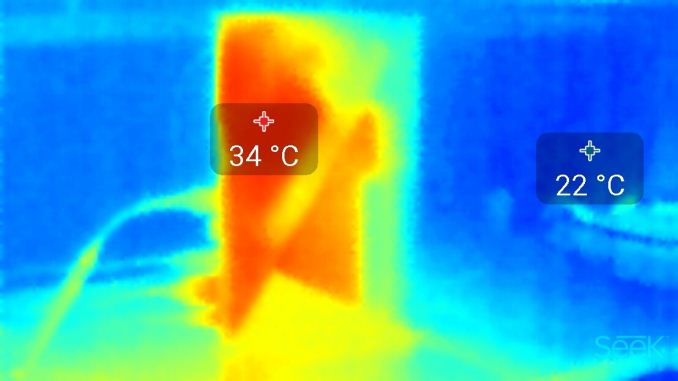The NVIDIA SHIELD Android TV Review: A Premium 4K Set Top Box
by Ganesh T S on May 28, 2015 3:00 PM EST- Posted in
- Media Streamer
- Home Theater
- TV
- 4K
- Shield
- NVIDIA
Power Consumption and Thermal Performance
In order to see what the power and thermal characteristics of the SHIELD Android TV are like, the device was tested in two scenarions:
- 1080p60 HDMI output to Pioneer VSX-32, connected to a Sony KDL46EX720 46" 1080p TV. Connected to a wired network, with a Samsung T1 SSD hanging off the USB 3.0 port
- 4Kp60 HDMI output to a Samsung HU6950 40" 4K TV. Connected to a wireless network, with a Samsung T1 SSD hanging off the USB 3.0 port.
The table below summarizes the important power consumption numbers.
| NVIDIA SHIELD Android TV Power Consumption | |
| Activity | Avg. Power (W) |
| Idle (Scenario 1) | 3.6 W |
| 1080p Netflix Streaming (Scenario 1) | 4.6 W |
| 1080p YouTube Streaming (Scenario 1) | 4.7 W |
| Kodi Playback (Hardware Accelerated 1080p60 H.264) (Scenario 1) | 6.5 W |
| Kodi Playback (Software Decoding 1080i60 VC-1) (Scenario 1) | 10.4 W |
| Idle (Scenario 2) | 4.2 W |
| 4K HEVC Playback (Scenario 2) | 9.1 W |
| 4K Netflix Streaming (Scenario 2) | 10.3 W |
| Gaming (Scenario 2) | 19.4 W |
Since the gaming scenarios stressed the at-wall power consumption heavily, we decided to run the GFXBench battery life test which puts the T-Rex benchmark in an infinite loop. After 2 hours, we took a thermal image of the unit (oriented vertically with the SHIELD stand).
The thermal solution is excellent, and the frame rates were consistent across all the benchmark runs. Thanks to the low-power SoC, the chassis temperature was just 34 C (ambient at 23 C). The fan noise was audible only when we kept our ears against the vents in the back panel.
Moving on to the business end of the review, we split up the positives and negatives into two sections - one for Android TV itself, and the other for the SHIELD.











167 Comments
View All Comments
ganeshts - Saturday, May 30, 2015 - link
It plays perfectly! As in, the audio seems to start a bit before the video starts, but when the pianist and the accompanying people start to speak, the audio and video are in sync.This was with the native Android Video Player
frankiepoon - Saturday, May 30, 2015 - link
Thx a lot, I will buy one then!OrphanageExplosion - Friday, May 29, 2015 - link
Android gaming just doesn't really work. The frame-pacing on every non-60fps title I've played is all over the place. So much judder :/AgeOfPanic - Friday, May 29, 2015 - link
Just wanted to complement you on the review. Somehow this site almost always manages to answer all the questions I have about a product I'm interested in. For me the current lack of refresh rate switching and bitstreaming of HD audio means that I'll pass for now, but I will follow the developments. I'm a little pessimistic, because the focus here is on streaming video and not HTPC use and there the lack of these features is less of a deal breaker.ruthan - Friday, May 29, 2015 - link
Yes, there is few design flaws and price for 500 GB model is too high, but it looks like best android gaming console without real competitor.fteoath64 - Tuesday, June 2, 2015 - link
Get the 16GB model and stick your own USB disk into it!. Solved.robertjan88 - Friday, May 29, 2015 - link
So, just to double check, file types like MKV, MP4 etc are fully supported for playback from an external HDD or SD-card? And x264 MKV?They're only listing H264 and 265, but no clue what the types are. :(
And what about the audio? Normal stereo, 5.1 and PCM are supported?
Many thanks for the feedback!
jwcalla - Friday, May 29, 2015 - link
As far as I know, container types have never been restricted on Android. It usually comes down to whether the software (app) supports them.BrokenCrayons - Friday, May 29, 2015 - link
Is there really that much of a market for non-mobile devices like this? I admit I don't know much about Android TV, but I guess if it supports a wireless keyboard and touchpad as well as letting you download an office suite it'd be somewhat flexible, but you still can't easily pick it up and take it with you to your couch or go to a coffee shop and use it to write while you're getting away from your apartment so it strikes me as extremely redundant with a tablet and even less useful in light of the fact that x86 Windows operating systems are now available on a tablet for lower cost than this screenless and batteryless device. Sure it's faster, but most of that performance is invested in graphical capabilities that aren't very important when you're playing a quick YouTube video, sending an e-mail, or writing something in a word processor. Plus, you have to also buy a screen for it which drives up the purchase price significantly since even a 15 inch screen would add another $100 or more.jwcalla - Friday, May 29, 2015 - link
You use a tablet as an HTPC?I don't think this device is intended for sending e-mails or writing documents.